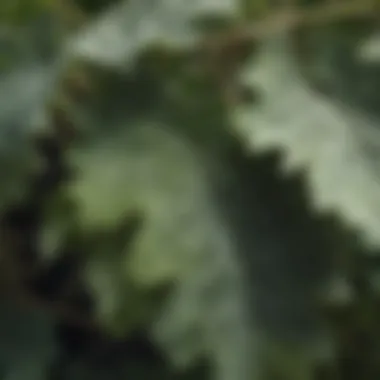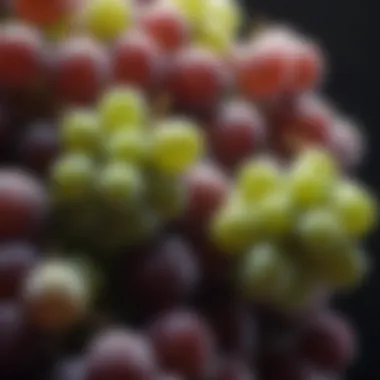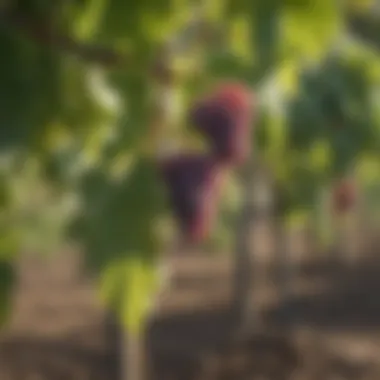Grape Powdery Mildew: Comprehensive Overview and Solutions


Intro
Grape powdery mildew, a persistent adversary in vineyards, is not merely an agricultural nuisance; it's a multifaceted issue that demands careful consideration. The primary culprit here is the fungus Erysiphe necator, which has a penchant for thriving in the conditions that grapevines often find themselves in. Identifying its impact is crucial for anyone involved in viticulture, from the small-scale farmer to large winery operators. This article seeks to delve deep into the many aspects of grape powdery mildew — its biology, its life cycle, and the methods to combat its insidious spread.
Navigating through the technicalities of this disease is essential for both understanding and mitigation. By unraveling its complexities, this piece serves as a vital tool for those affected by it. Through an informal yet informative style, we'll explore where this fungal foe comes from, the havoc it wreaks on grape quality and yield, and the strategies that can be employed to protect vineyards.
As we embark on this exploration, we will uncover not only the harsh realities of grape powdery mildew but also the innovations that are making waves in the field of viticulture, offering fresh hope to growers and researchers alike.
Preamble to Grape Powdery Mildew
Grape powdery mildew is one of the most significant challenges facing vineyards and grape production worldwide. As an obligate biotroph, the fungus Erysiphe necator feeds on the living tissues of grapevines, leading to a cascade of repercussions that impacts not just the health of the vines, but also the quality of the grapes they produce. Understanding this disease is crucial for viticulturists, researchers, and enthusiasts alike. Knowledge about powdery mildew empowers growers to take proactive steps, ultimately protecting their yields and financial investments.
Overview of Powdery Mildew
Powdery mildew can appear on grapevines as a powdery white coating, usually seen on leaves, stems, and grape clusters. The issue arises typically in warm, dry climates where conditions favor its development. Unlike other fungal diseases that thrive in wet conditions, powdery mildew prefers humidity below 90%. This unique characteristic means that even in vineyards where rainfall is sparse, growers must remain vigilant. The spores produced by Erysiphe necator can be exceptionally hardy, capable of surviving through adverse conditions. Spread by wind, these microscopic contenders can swiftly invade new hosts, turning a few infected leaves into a widespread problem within days.
Historical Context
Historically speaking, the battle against grape powdery mildew isn't a new one. It can be traced back to the European vineyards of the 19th century, where it first made its infamous appearance. Growers then had little knowledge about the nature of the disease and often suffered devastating losses. The introduction of sulfur-based fungicides in the late 1800s marked a turning point in managing this ailment. However, even with these controls, the fungus evolved continually, burdening grape producers with the challenge of resistant strains. As the years rolled on, research flourished, bringing forward integrated pest management strategies and organic alternatives that now coexist with chemical methods. Understanding how our ancestors responded to the powdery mildew problem can provide insights relevant today. The evolving relationship with this pathogen continues to highlight the necessity for ongoing research and innovation in the field.
"The struggle against powdery mildew is not just a fight for the grapes, but a testament to human ingenuity in agriculture."
In sum, grappling with grape powdery mildew brings together historical context, biological intricacies, and practical implications into a multifaceted issue that demands attention. By delving into the depths of this topic, we can better appreciate the challenges faced by vineyard managers and the essential nature of a coordinated response to a persistent foe.
Identifying Grape Powdery Mildew
Identifying grape powdery mildew is crucial for effective management and control of this pervasive disease. Timely recognition allows for prompt interventions that can safeguard the health of vineyard crops. Early detection is often the key to protecting grape quality and ensuring high yields. Grapevines are particularly vulnerable to various threats, and knowing how to spot early signs of powdery mildew can mean the difference between a thriving harvest and devastating loss.
Symptoms on Grapevines
When it comes to symptoms on grapevines, the first thing to note is the characteristic white, powdery coating that appears on leaves, stems, and fruit. This is primarily a result of the hyphal growth of the fungal pathogen, Erysiphe necator.
Other common symptoms include:
- Leaf Discoloration: Leaves may turn yellow or exhibit a mottled appearance as the disease progresses.
- Curling Leaves: Infected leaves may curl or become distorted in shape due to fungal activity.
- Stunted Growth: Overall growth of the vine may slow down, as resources are diverted towards combating the fungus.
- Reduced Berry Quality: As the fruit begins to develop, powdery mildew can result in reduced sugar levels and altered flavor profiles.
Identifying these symptoms promptly is vital, as they accentuate a larger issue threatening the vineyard's essence.
Life Cycle of Erysiphe necator
Understanding the life cycle of Erysiphe necator is key to managing grape powdery mildew effectively. The fungus has a complex life cycle consisting of several stages that contribute to its persistence and transmission. Each phase plays a vital role in how the disease spreads and affects grapevines.
Conidial Stage
The conidial stage is particularly notable for its ability to propagate rapidly under the right conditions. Conidia, which are asexual spores, are produced on the surface of infected tissues. They are lightweight and easily dispersed by wind or water, facilitating rapid transmission across the vineyard.
One key characteristic of the conidial stage is its high reproductive capacity, allowing the fungus to quickly establish new infections. As a result, this stage is pivotal in understanding how infections can bloom seemingly overnight.


A unique feature of this stage is its adaptability; it can persist in less than ideal conditions, ensuring that Erysiphe necator remains a constant threat. This adaptability is a significant consideration when developing control strategies, as late detection during this phase can compromise vineyard health.
Asci and Ascospores
The asci and ascospores stage follows the conidial stage and represents the sexual reproduction phase of Erysiphe necator. Asci contain ascospores, which can survive through adverse conditions, allowing the fungus to endure periods of drought or unfavorable temperatures.
A key characteristic of ascospores is their resilience. They can remain dormant for extensive periods until conditions become favorable for germination. This aspect of the life cycle means that even when visible symptoms have waned, the potential for future outbreaks remains.
The primary disadvantage in this stage is that it can complicate detection efforts. Ascospores can exist in a hidden form, only to manifest when conditions turn ideal for their growth, unsuspectingly reigniting the cycle of infection.
Environmental Influences
Environmental influences play a critical role in shaping the life cycle of Erysiphe necator. Factors such as humidity, temperature, and moisture levels significantly affect its growth and proliferation.
Key environmental influences include:
- Temperature Ranges: Powdery mildew thrives in warm, dry conditions—typically between 20°C to 29°C—making grapevines particularly vulnerable during specific seasons.
- Humidity Levels: High humidity can promote spore germination, while too much moisture can inhibit overall growth. This necessitates careful monitoring in vineyards.
- Vineyard Management Practices: Canopy management, irrigation schedules, and canopy density can all influence the micro-environment where vine infections develop.
Recognizing how these environmental conditions facilitate or hinder fungal development is pivotal for implementing pre-emptive strategies, minimizing potential outbreaks before they spiral out of control.
Impact of Powdery Mildew on Grapes
The presence of grape powdery mildew, instigated by the fungus Erysiphe necator, possesses a disruptive effect that permeates various aspects of viticulture. Understanding its impact is crucial not merely for academic discourse but also for practical implications in the vineyard. Grapes are the backbone of many economies and cultures, and their vulnerability to diseases can shift the entire industry landscape. As we delve into the specific repercussions of this pathogen, a clearer picture emerges about why managing mildew is a priority.
Effect on Grape Quality
Quality, in the context of winemaking, is often synonymous with flavor and aroma. Powdery mildew adversely affects these characteristics by diminishing the overall berry quality. Infected grapes tend to exhibit altered sugar levels, leading to a lackluster fermentation process. Moreover, the visual attributes suffer; clusters may become less attractive, presenting a dappled appearance due to fungal growth. This is not just a cosmetic issue; it can deter buyers and impact perceived value in the market.
When grapes are covered in a powdery coating, the essential compounds, such as phenolics and acids, may also become imbalanced. These changes challenge winemakers striving for consistency and can lead to unpredictable flavors in the final product. Thus, the influence of powdery mildew on grape quality is multifaceted, affecting both aesthetic and sensory experiences, making it vital for vine growers to maintain vigilance against this menace.
Impact on Yield and Vine Health
The ramifications extend beyond just quality into the yield and overall health of the vines. Grape powdery mildew inhibits photosynthesis by blocking light distribution essential for leaf vitality. In turn, this affects the growth rate of the vine and the size of the harvest. Grapes may ripen unevenly, and in severe cases, premature defoliation can occur.
The affect on yield can be staggering. For instance, a vineyard suffering from moderate to severe infections could experience a drop in yield by upwards of fifty percent in some scenarios. Concerns don't end with just one season; persistent infections can lead to long-term declines in vine vigor. Vines that struggle year after year might never fully recover, creating a cycle of diminishing returns.
Moreover, the resilience of the vineyard itself can be compromised. A healthy vine can ward off some diseases, but when powdery mildew is present, trees can become gateways for other pathogens, leading to a cascading effect. Maintaining plant health is crucial for sustaining both longevity and productivity in grape farming.
Economic Implications for Viticulture
The financial stakes associated with grape powdery mildew capture the attention of vineyard owners everywhere. The costs associated with managing mildew stretch far and wide. Initially, vineyards must contend with the price of fungicides and their application; these can add up rapidly. However, chemical measures alone may end up being ineffective or lead to resistance, necessitating a shift to more sustainable practices that can require further investment.
When considering lost yields due to infection, the economic impact heightens. In addition to the immediate loss of fruit, vineyards may face repercussions in future sales due to damaged reputation or decreased customer loyalty when inconsistent quality reaches the market. Many wineries may find themselves in a tight spot, spending more on preserving their products than they earn, a precarious balance that threatens the very existence of the vineyard.
In summary, the effects of grape powdery mildew on grapes resonate deeply, touching on quality, yield, and financial health. The challenges it poses to viticulture are both complex and critical, necessitating ongoing research and innovative strategies to mitigate its advances. Understanding these impacts is paramount for anyone invested in the grape industry.
Control Strategies for Grape Powdery Mildew


Inflicting significant harm on grape crops, controlling powdery mildew necessitates a multifaceted approach. Viticulturists must adopt varied strategies in tandem to mitigate the effects of Erysiphe necator. This section examines proactive and reactive measures, balancing effectiveness, costs, and practicality.
Cultural Practices
Canopy Management
Canopy management embodies the art of manipulating the growth of grapevines to enhance vine health and fruit quality. This practice focuses on controlling the density of the foliage to allow for adequate air circulation and sunlight penetration. By ensuring these conditions, it becomes harder for powdery mildew to spread, as the fungus thrives in humid, dark environments.
Key to successful canopy management is the timing of pruning and training. For example, properly timed summer pruning can help reduce moisture retention within the canopy. This practice is beneficial because it directly sharpens the vine's resistance against mildew developments.
Unique to canopy management is its ability to not only lessen mildew pressure but also boost overall grape quality. It’s like giving your vines a breath of fresh air; however, one must be wary of over-pruning as this can stress the vine and potentially lower yields. So, it's a careful balance that any grower must strike.
Sanitation Measures
Sanitation measures are essential in the fight against grape powdery mildew, serving as the frontline defense. Regular maintenance and cleanliness of the vineyard play a crucial role in preventing disease outbreaks. This includes removing fallen leaves, old fruit, and other organic material that could harbor the spores of powdery mildew.
One key characteristic of sanitation measures is the requirement for diligence. It’s not just a one-time act, but rather ongoing vigilance. Adopting these practices helps reduce the initial inoculum that can infect healthy plants, making it particularly popular among organic growers.
A unique feature of sanitation measures is the ability to combine them with other strategies, amplifying their effectiveness. However, it does necessitate significant labor and time investment. For growers with limited resources, this can pose a challenge.
Chemical Control Methods
Fungicides: Types and Effectiveness
Fungicides are powerful allies in controlling grape powdery mildew. These chemical treatments vary widely, with some primarily preventing the disease while others address existing infections. Systemic fungicides are absorbed by the plant, providing protective action from within, while contact fungicides work by forming a barrier on plant surfaces.
The key characteristic of fungicides is their targeted action against specific fungi, thus offering a focused impact. They are a favored choice because they can yield rapid results, vital in the face of an advancing outbreak. Flexibility in choice allows growers to tailor their approaches based on the infection stage and specific conditions.
However, the unique downside is the potential for developing resistant strains of the fungus due to repeated use of the same type. Mixing different classes of fungicides can help mitigate this risk, but it highlights the importance of integrated management to avoid dependency on just chemical solutions.
Application Timing and Rates
Application timing and rates of fungicide are crucial components of an effective powdery mildew management strategy. There is a fine line between being too early and too late with fungicide application. Ideally, treatments should start before the first symptoms appear, utilizing weather models to guide decisions about when to spray.
A hallmark of this method is precision. Calculating the right application rate ensures that fungicide is effective without harming the plants or the environment. This tailored approach boosts the chances of maintaining grape quality while minimizing excess chemical usage, preserving vineyard health.
The challenge lies in the variability of environmental conditions that can affect efficacy. Rainfall, for instance, can wash away treatments, necessitating follow-up applications. Growers must remain vigilant, adapting their strategies to the weather, which adds another layer of complexity.
Biological Control Options
Predatory Fungi
Predatory fungi offer an environmentally friendly alternative to manage powdery mildew. They function by preying on Erysiphe necator, effectively reducing its numbers, which can be a game-changer for sustainable grape production. This method aligns well with integrated pest management strategies, appealing to conscious growers.
What sets predatory fungi apart is their capacity for self-propagation in the vineyard. Once established, they can persist in the ecosystem, providing an ongoing defense against mildew. This natural solution not only lowers reliance on chemicals but also supports biodiversity in the vineyard ecosystem.
However, the success of this approach hinges on several factors, including the formulation of the product and environmental conditions. Moreover, establishing a population of predatory fungi can take time, necessitating patience from growers.


Microbial Inoculants
Microbial inoculants represent another innovative biological control strategy, utilizing beneficial microorganisms to suppress the growth of Erysiphe necator. By applying these biocontrol agents, the natural balance in the vineyard can be restored. These products enhance overall plant health, often resulting in improved resistance to stress and disease.
The unique characteristic of microbial inoculants is their dual role; they not only combat powdery mildew but also boost vine vigor and soil health. This holistic approach is gaining ground among growers targeting sustainable practices.
However, applying microbial inoculants isn't without its hurdles. The effectiveness can vary depending on several external factors, such as soil health and climate conditions. Uneven performance may dissuade some growers who seek guaranteed results.
By incorporating a mix of cultural, chemical, and biological strategies, grape growers can create a comprehensive approach to managing powdery mildew, safeguarding their vineyards against this relentless threat.
Research Trends and Future Directions
The area of research focused on grape powdery mildew is continuously evolving, particularly as the environmental, agricultural, and economic landscapes shift. This section highlights several crucial trends driving forward our understanding of this persistent challenge in viticulture. As scientists and growers alike seek solutions that can mitigate the effects of Erysiphe necator, understanding these trends is paramount. It is not just about controlling current outbreaks but preparing for future scenarios that could arise due to broader ecological changes.
Emerging Biological Control Strategies
Biological control strategies are gaining prominence as viable alternatives to traditional chemical methods. Researchers are exploring various microorganisms, including fungi and bacteria, that can naturally suppress powdery mildew. For instance, specific strains of Trichoderma, a genus of fungi, have shown potential in outcompeting Erysiphe necator on grape leaves. These beneficial organisms can be introduced into grape-growing environments to bolster the natural defenses of vines and reduce the reliance on synthetic fungicides, which can have adverse environmental impacts and contribute to resistance.
Investing in these biological methods not only allows for sustainable pest management but could lead to a healthier terroir overall. Fostering these microbial relationships can enhance not just vine health but the integrity of the whole ecosystem. However, the practical implementation of these strategies requires further research and trials to understand better the specific conditions under which these biological agents thrive.
Genetic Resistance in Grapevines
Another promising avenue in combating grape powdery mildew involves genetic resistance breeding. Researchers have been identifying Vitis species with inherent resistance traits. Notably, some wild grape varieties exhibit a notable ability to withstand powdery mildew infections. By analyzing the genetic makeup of these resistant vines, scientists can potentially introduce these traits into cultivated varieties through traditional breeding or genetic engineering. Such innovations could revolutionize how growers manage powdery mildew, reducing their dependence on chemical treatments.
Pursuing genetic resistance also involves assessing the response of these genetically modified plants to various environmental stresses. Grapes not only need to resist mildew but should also perform well in various climatic conditions. This balance is crucial, as producing a resistant grape under a controlled environment might not reflect real-world challenges.
Climate Change Implications
As climate change unfolds, its implications on grape powdery mildew become increasingly evident. Forecast models predict that rising temperatures and changing rainfall patterns could foster conditions that might enhance the prevalence of this fungus. Warmer temperatures can lead to higher humidity levels, which are favorable for the proliferation of Erysiphe necator. Understanding these climatic shifts is pivotal in developing adaptive strategies for growers.
Moreover, studies suggest that different grape varieties may respond inconsistently to climate fluctuations. Some varieties might become less resistant or even more susceptible under new climate scenarios. Grapevines might need to be reassessed for their suitable growing conditions, considering these trends with more urgency than ever.
"Without proactive measures and adaptability to climate influences, the future of grape cultivation might be at risk."
Conducting extensive research on these climate impacts, coupled with the ongoing development of adaptive viticultural practices, will be essential for sustainable grape production moving forward.
Ending
Understanding grape powdery mildew is not just an academic exercise; it holds significant practical implications for viticulture. As discussed throughout this article, the challenges posed by Erysiphe necator are multifaceted, affecting grape quality, vine health, and ultimately the economic viability of vineyards. This conclusion aims to encapsulate the critical elements of the previous sections while stressing the ongoing relevance of research and collaboration in combating this pervasive threat.
Summary of Key Points
In summary, several key points emerge from our analysis of grape powdery mildew:
- Identifying Symptoms: Recognizing early symptoms on grapevines is paramount. White powdery spots on leaves can escalate rapidly if left unchecked.
- Life Cycle Insights: Understanding the life cycle of the fungus helps in tailoring effective control strategies. Each stage—from conidia to ascospore production—presents unique vulnerabilities.
- Impact on Quality and Yield: The economic implications of powdery mildew are profound. Affected grapes may have compromised quality, leading to lower market prices and diminished harvests.
- Control Strategies: Diverse strategies exist, ranging from cultural practices to biological and chemical control options. An informed approach can significantly mitigate risk.
- Research Trends: Continuous research into genetic resistance and emerging biological controls shows promise for long-term sustainability in vineyard management.
The interplay of these elements provides a comprehensive understanding of how to manage and mitigate the effects of this disease, ultimately ensuring the vitality of vineyards for future generations.
Call for Continued Research and Collaboration
As the landscape of agriculture evolves, so too does the challenge of grape powdery mildew. The urgency for ongoing research cannot be overstated. Collaboration between researchers, practitioners, and educational institutions is crucial for several reasons:
- Adapting to Change: Climate change introduces new variables into grape cultivation, affecting both the prevalence and behavior of powdery mildew. Collaborative efforts are essential to assess these evolving dynamics.
- Innovative Solutions: The cultivation of new grape varieties that exhibit genetic resistance necessitates teamwork amongst geneticists, agronomists, and vineyard owners. This multidisciplinary approach can yield more resilient crops.
- Shared Knowledge: Platforms for knowledge sharing, whether through academic journals or forums like Reddit, can foster innovation and improvement in control practices.
- Community Engagement: Grassroots movements and partnerships with local growers can enhance awareness and implementation of best practices. Connecting institutions and individual growers ensures that research findings translate into actionable strategies.



